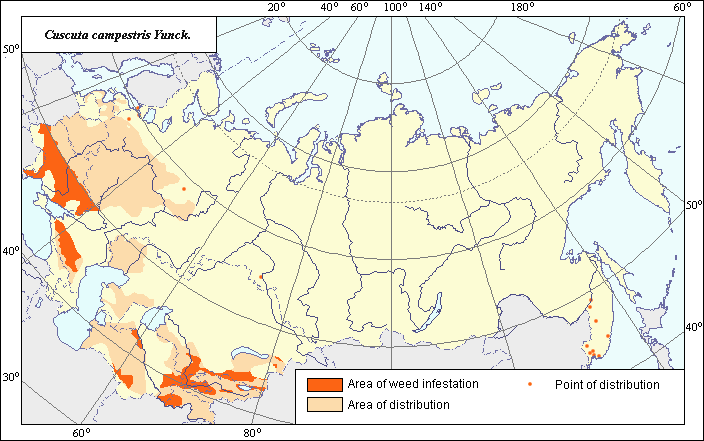Weeds
Area of distribution and weediness of Field Dodder (Cuscuta campestris Yunck.)
 Object description Download GIS-layers
Object description Download GIS-layers
Authors:
Object specialist A.Yu. Doronina,GIS-specialist I.A. Budrevskaya.
Date of creation:
20.01.2005.Scale:
1:20 000 000.Accuracy of map:
Map was created based on materials of maps of natural scale 1:15 000 000-1:100 000 000 and on information taken from open-published literature.Projection:
.Alber's Equal Area Conic for the USSR., 9, 1001, 7, 100, 0, 44, 68, 0, 0Basic contents:
Vector map. Area of species distribution is shown by polygons, and sporadic distribution by points. Zones of weediness are shown by polygons.Accuracy of classifier:
The weed area is subdivided into two zones, one representing species distribution, and the second where the weed is considered a serious pest. Points represent locations where sporadic occurrence has been reported. Within the weed area the zones of weediness are shown where C. campestris is pernicious. Within the weed area the zones of weediness were outlined according to criteria of occurrence and abundance (Tanskii et al., 1998), i.e., where the occurrence of C. campestris exceeds 20% with its abundance at 2-3 points.Method of map production:
Published literature was reviewed, including Atlases, monographs and papers. Occurrence data were obtained from herbarium specimens, floras, monographs and papers. The northern, southern, western, and eastern boundaries of the area were outlined according to Nikitin (1983); the northern, southern, and eastern boundaries of the area were outlined according to Pavlov (1964). The sporadic distribution was determined according to Karkhevich (1995) and Tolmachev & Tsvelev (2000), Doronina (2003) and the herbarium of the V.L. Komarov Institute. The zone of weediness was determined according to Nikitin (1983), Ulyanova (1998) and was specified according to data on abundance, frequency of occurrence or weediness of the weed, gathered from the below-mentioned references (except Keys and Flora). Data were then compiled through scanning and geo-referencing to develop a composite vector map. The biologist, together with the GIS specialist, drew a composite weed distribution area based on compiled data.Reference citations:
Artokhin K.S.. 2004. Atlas Weed plants. Rostov-na-Donu. 144 p. (In Russian)Baranova O.G., Il.minskikh N.G., Puzyrev A.N., Tuganaev V.V. 1992. The synopsis of flora of Udmurtia. Izhevsk: Udmurtian University. 140 p. (In Russian)
Beilin I.G. 1967. Control of dodders and broomrapes. Moscow: Kolos. 88 p. (In Russian)
Butov A.Ya. 1958. Some regularity in distribution of species of the genus Cuscuta L. in Middle Asia. Works of V.I. Lenin Middle-Asian State University. Botany. Tashkent: SAGU. 57-61 p. (In Russian)
Doronina, A.Yu. 2003. Flora of the vascular plants. In: Volkova E.A., Khramtsov V.N., Isachenko G.A., eds. Natural environment of the coastal area and water body of the gulf of Finland (region of port Primorsky). Saint Petersburg. 55-68 p. (In Russian)
Fisyunov A.V., ed. 1984. Weed control reference book. Moscow: Kolos. 254 p. (In Russian)
Gubanov A.I., ed. 1995. Manual of the vascular plants of the center of European Russia. Moscow: Argus. 560 p. (In Russian)
Kotov, M.I. & A.I. Barbarich, eds. 1957. Flora of the Ukraine. Kiev: Ac. Sc. Ukrainian SSR. 543 p. (In Ukrainian)
Krasnoborov I.M., ed. 2003. Manual of plants of Altai Territory. Novosibirsk: SO RAN. 634 p. (In Russian)
Kuusk, V. 1996. Flora of the Baltic republics (list of vascular plants). V. 2. Tartu: Eesti Loodusfoto AS. 372 p. (In Russia)
Maevskii, P.F. 1954. Flora of middle belt of the European part of the USSR. Moscow-Leningrad: Selkhozgiz. 912 p. (In Russian)
Malyshev, L.I. & G.A. Peshkova, eds. 1979. Flora of Central Siberia. V. 2. Novosibirsk: Nauka. 1048 p. (In Russian)
Malyshev, L.I., ed. 1991. Flora of Siberia (Pyrolaceae-Lamiaceae). V. 11. Novosibirsk: Nauka. 296 p. (In Russian)
Nikitin V.V. 1983. Weeds in the flora of the USSR. Leningrad: Nauka. 454 p. (In Russian)
Pavlov, N.V., ed. 1964. Flora of Kazakhstan. V. 7. Alma-Ata: AN Kazakh SSR. 498 p. (In Russian)
Pilyugin N. 1953. Dodder and its control. Yaroslavl: Kolhoz i sovkhoz literature. 19 p. (In Russian)
Shatalov T.A. 1987. Weed plants and their control in Rostov Region. Persianovka. 102 p. (In Russian)
Shishkin, B.K., ed. 1953. Flora of the USSR. V. 19. Moscow-Leningrad: AN SSSR. 752 p. (In Russian)
Shishkin, B.K., ed. 1955. Flora of BSSR. Minsk: AN BSSR. 525 p. (In Russian)
Tanskii V.I., Levitin M.M., Ishkova T.I., Kondratenko V.I. 1998. Phytosanitary diagnostics in integrated management of cereals. In: Novozhilov K.V., ed. Compendium of methodical recommendations in plant protection. St. Petersburg: VIZR. 5-55 p. (In Russian)
Tsvelev N.N. 2000. Keys to the vascular plants of North-West Russia (Leningrad, Pskov and Novgorod Regions). Saint Petersburg: SPbSCPA press. 781 p. (In Russian)
Ulyanova T.N. 1989. Field weed plants of cotton in the USSR. In: Agaev M.G., ed. Catalogue of VIR world collection. N. 499. Leningrad: VIR. 15, 40 p. (In Russian)
Ulyanova T.N. 1998. Weeds in the flora of Russia and other CIS states. St. Petersburg: VIR. 344 p. (In Russian)
V.L. Komarov Botanical Institute [LE], St. Petersburg, Russia.
Vvedenskii, A.I., ed. 1961. Flora of Uzbekistan. V. 5. Tashkent: AN Uz. SSR. 668 p. (In Russian)

